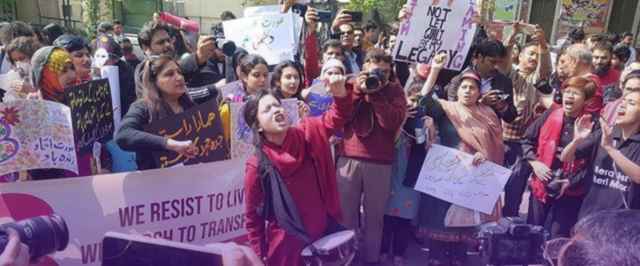Asma Aamir
Posted March 29, 2024

[This text is edited from a speech Asma Aamir gave at the 13th International Meeting of the World March of Women, October 2023 in Ankara, Turkey. She speaks about Pakistani feminist movement’s history, their work and challenges.]
I WOULD LIKE to talk about Pakistan, a country that has no secular State. It is officially the Islamic Republic of Pakistan, run by the federal and provincial governments, following the Constitution of 1973. The Judiciary system is divided into civil courts, criminal courts and the Sharia court, which examine the laws of the country in compliance with the Islamic law and rights.
The Federal Shariat Court is the only authority which holds the constitutional power to prohibit and prevent the enactment of laws which are deemed to be un-Islamic by the parliament of Pakistan. It is predominantly focused on examining new or existing law of Pakistan. If a law violates the Quran, sunnah or hadith, the Shariat Court will prohibit its enactment.
The Constitution of 1973 guarantees, in its article 16, the freedom of assembly; in article 17, the freedom of association; and in article 19, the freedom of speech and expression. All this should empower every citizen to exercise their fundamental rights, without any discrimination. The absence of these rights is the biggest stumbling block preventing the growth of any society.
The increasing human rights violations are an open threat to democracy and the work of human rights defenders. The Constitution guarantees these rights, but they are not being exercised in practical life. They are particularly violated when it comes to women’s rights. There is limited room for freedom of expression, speech and assembly for women and young girls.
During and after the pandemic, inflation has increased poverty as well as have multiple socio-economic and political challenges within Pakistan’s diverse social fabric. Ethnic and religious minorities are impacted the most as we also experience growing divisions between urban and rural spaces, and between big and small cities. All these are contributing factors to the changes in the social behavior of the masses.
The pandemic reduced workforce participation across all economic sectors, resulting in the loss of many jobs. Working-class women, especially factory working women and domestic workers, suffered most. Teachers were fired from their jobs immediately. And violence against women and girls increased during the pandemic.
Feminism in Pakistan History
With all these challenges, insecurity among minorities in Pakistan has increased. In the 1980s, during the dictatorial and anti-women regime of Zia ul Haq, civic spaces for women were narrowed. During that period, the government made effective use of religious political forces to achieve its power. It silenced political parties, censored the press and academy, and banning student and trade union movements.
Ethnic and religious intolerance is routine, with cases only reported now and then.
During this political moment in the 1980s the first feminist organization, the Women’s Action Forum, gained momentum. Women gathered and worked to repeal the Hudood Ordinances, laws enacted in 1979, which discriminated against non-Muslim women regarding witness evidence in cases of rape or gang rape.
They organized a rally to protest the Law of Evidence, which demanded four witnesses to prove rape was committed, as well speaking out against other laws that discriminate against women. The demonstration happened in The Mall Road, in the city of Lahore, where I live.
Despite the peaceful action, tear gas was used to disperse the crowd and arrests were made. The Women’s Action Forum was —and still is— a voice against injustice, especially when used against women and minorities. Later, in 2006, the laws were reformed, and four witnesses are no longer required.
The second popular feminist organization, the Alliance Against Sexual Harassment (AASHA), began in 2000. Its focus is to stop sexual harassment at workplace. Activist and gender expert Fouzia Saeed, along with other sisters such as World March of Women member Bushra Khaliq, engaged key stakeholders including grassroots women, media, parliamentarians and political parties to demand an end to harassment. By 2010 they won legal protection.
Then in 2018, the current grassroots movement Aurat March [Women’s March, in English] gained momentum with the motto of ending patriarchy. As a movement of young feminist girls, it has a more inclusive and intergenerational approach. The Aurat March is held annually on March 8. Throughout the year they hold smaller demonstrations, organize artistic work and release press releases on social issues.
Contemporary Challenges
While exercising their constitutional right to assembly and freedom of speech, young feminists face death, rape and acid-throwing threats. Raising feminist slogans has a troubled and distressed history given the patriarchal mindset in Pakistan.
The social fabric, structure and practices are against women. Governmental protection for women is weak. Women face opposition in their homes, on the streets and at their workplaces. but we march in the streets on International Women’s Struggle Day.
Currently many young girls are sent online bashing comments and email messages that make them feel insecure. Consequently they stop posting in public spaces, or, when they ignore those comments, face fear and insecurity. Electronic and print media have published doctored posters with images of girls and women who joined rallies and marches, including me. Media and YouTubers’ are employing tactics that are detrimental to the cause of girls and women.
Growing rightwing populism use of technology reveals how society is still unwilling to provide bodily rights to girls and women. The slogan “mera jism meri marzi” (“my body, my choice”) became young feminists’ daring and bold expression. This slogan denies patriarchal control over women’s bodies, particularly in cases of marital rape and childbearing without choice.
We see the space for dissent is contracting in the Asia-Pacific region. Similarly, civic spaces and young feminist movements in Pakistan are endangered.
Threats to the very lives of marchers have increased. Now women must deal with cyber harassment, sexual harassment in public places and being stigmatized by fundamentalisms, rightwing sectors and the absence of secularism. All these are the emerging challenges for the State and communities as we demand they consider women equal citizens, demand pro-women policies, and claim our rightful civic space.
Under the banner of the World March of Women, we see our way forward is through mobilizing and strengthening the capacities of hundreds of young girls through movement building. Through daily activism, we will continue the struggle for women’s rights and structural changes. That is why we say that “we resist to live, we march to transform.”
CAPRE, February 9, 2024


Leave a Reply